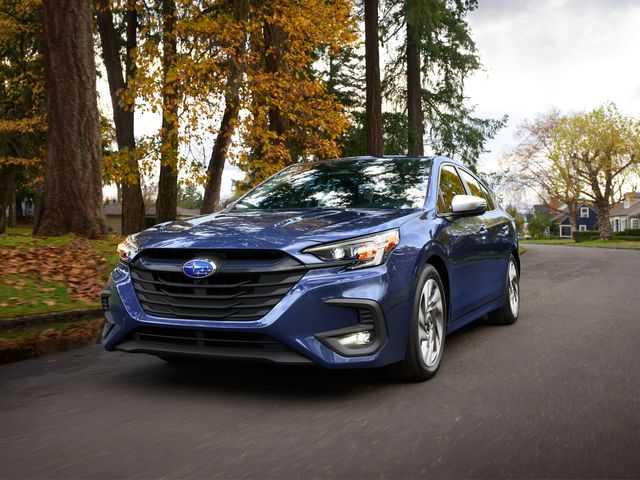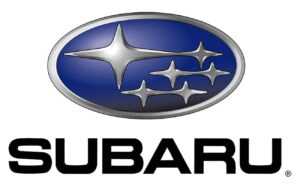Subaru Legacy 2023 Child Restraint Systems Touring XT
The 2023 Subaru Legacy Touring XT’s cutting-edge child restraint features show a strong commitment to kid safety. The cutting-edge LATCH (Lower Anchors and Tethers for Children) system, which offers safe and convenient anchor points for child safety seats, is installed in this family-friendly car. The design minimizes movement during travel by ensuring that kid seats can be placed easily and steadily. The Legacy Touring XT has rear seat designs that support multiple child seat types, including booster seats, in addition to the LATCH system, guaranteeing compatibility and safety for kids of all ages. Families looking for a midsize sedan that offers comfort and security will find the Touring XT to be an appealing option thanks to its emphasis on child safety and the extensive safety features found in the Legacy.
2024 Subaru Legacy Specs, Price, Features, Mileage (Brochure)
Child restraint systems
Infants and small children should always be placed in an infant or child restraint system in the rear seat while riding in the vehicle.
You should use an infant or child restraint system that meets Federal Motor Vehicle Safety Standards or Canada Motor Vehicle Safety Standards, is compatible with your vehicle, and is appropriate for the child’s age and size. Children could be endangered in an accident if their child restraint systems are not properly secured in the vehicle. When installing the child restraint system, carefully follow the manufacturer’s instructions. According to accident statistics, children are safer when properly restrained in the rear seating positions than in the front seating positions. All U.S. states and Canadian provinces require that infants and small children be restrained in an approved child restraint system at all times while the vehicle is moving.
Lock release button
- Unlocked
- Locked
An Unlocking marker in red
WARNING
- Before installing a child restraint system, be sure to confirm that the seatback is securely locked into place. Otherwise, in an accident, serious injury or death could result.
- Do not leave children in the car unattended. High interior temperatures may cause heat stroke and dehydration that result in serious injury or death.
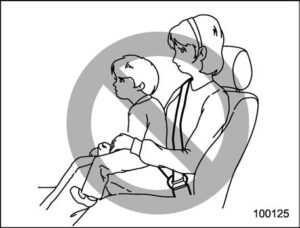
WARNING
Never let a passenger hold a child on his or her lap or in his or her arms while the vehicle is moving. The passenger cannot protect the child (or infant) from injury in a collision, because the child will be caught between the passenger and objects inside the vehicle. Additionally, holding a child in your lap or arms in the front seat exposes that child to another danger. Since the SRS airbag deploys with considerable speed and force, the child could be injured or even killed.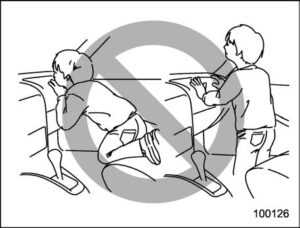
WARNING
Children should be properly restrained at all times. Never allow a child to stand up, or kneel on any seat. Unrestrained children will be thrown forward during a sudden stop or in an accident and can be injured seriously. Additionally, children standing up or kneeling on or in front of the front seat are exposed to another danger. Since the SRS airbag deploys with considerable speed and force, the child could be injured or even killed.
Safety tips for installing child restraint systems
- Child restraint systems and seatbelts can become hot in a vehicle that has been closed up in sunny weather; they could burn a small child. Check the child restraint system before you place a child in it.
- Do not use a seatbelt extender. If a seatbelt extender is used when installing a child restraint system, the seatbelt will not securely hold the child restraint system. Use of a seatbelt extender could cause death or serious injury to children or other passengers in sudden braking, swerving, or accidents.
- Attach the child restraint system to the anchors properly. When using the LATCH anchors, be sure that there are no foreign objects around the anchors. Make sure the child restraint system is securely attached. Otherwise, it may cause death or serious injury to children or other passengers in sudden braking, swerving, or accidents.
- Do not leave an unsecured child restraint system in your vehicle. Unsecured child restraint systems can be thrown around inside of the vehicle in a sudden stop, turn, or accident; they can strike and injure vehicle occupants as well as result in serious injuries or death to the child.
CAUTION
When you install a child restraint system, follow the manufacturer’s instructions supplied with it. After installing the child restraint system, check to ensure that it is held securely in position. If it is not held tight and secure, the danger of your child suffering personal injury in the event of an accident may be increased.
Where to place a child restraint system
The following descriptions are SUBARU’s recommendations on where to place a child restraint system in your vehicle.
WARNING
- Several types of child restraint systems may conceal the buckle of the neighboring seat. If the occupant of the neighboring seat cannot correctly fasten the seatbelt, that person must move to a different seat. If the seatbelt cannot be correctly fastened, there is the risk of serious injury or death in the event of sudden braking or a collision.
- If the child restraint system cannot be correctly installed because it contacts the driver’s seat, moves the child restraint system to a different seat. If it cannot be installed in a different seat (other than the driver’s seat), adjust the front seat so that contact does not occur.
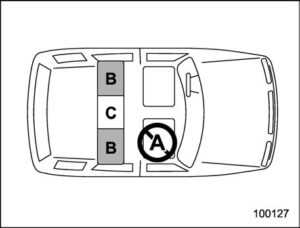
A: Front passenger’s seat
You should not install a child restraint system (including a booster seat) due to the hazard to children posed by the passenger’s airbag.
B: Rear seat, window-side seating positions Recommended positions for all types of child restraint systems. In these positions, the following equipment is provided for installing a child restraint system.
- Automatic Locking Retractor/Emergency Locking Retractor (ALR/ELR) seatbelts
- Lower anchorages (bars)
- Upper anchorages (tether anchorages) Some types of child restraint systems might not be able to be secured firmly due to the projection of the seat cushion.
In this seating position, you should use only a child restraint system that has a bottom base that fits snugly against the contours of the seat cushion and can be securely retained using the seatbelt.
C: Rear seat, center seating position In this position, the following equipment is provided for installing a child restraint system.
- ALR/ELR seatbelts
- Top tether anchorages
Some types of child restraint systems might not be able to be secured firmly due to the projection of the seat cushion. In this seating position, you should use only a child restraint system that has a bottom base that fits snugly against the contours of the seat cushion and can be securely retained using the seatbelt. The rear center seat includes lower anchorages and the lower anchorages on the center side of the rear right seat can be used to install a child restraint system. When a child restraint system is installed in the rear center seat using the lower anchorages, do not sit in the rear seat. If a child restraint system is not correctly fixed in place (for example, if a child restraint system can be moved more than 1 inch (2.5 cm) from side to side), the child restraint system should be moved to a window seat position of the rear seat.
WARNING
- Even with advanced airbags, children can be seriously injured by the airbag. Seat children in the rear seat properly restrained at all times. The SRS airbag deploys with considerable speed and force and can injure or even kill children, especially if they are not restrained or improperly restrained. Because children are lighter and weaker than adults, their risk of being injured from deployment is greater.
- For that reason, be sure to secure ALL types of child restraint systems (including forward-facing child restraint systems) in the REAR seats at all times. You should choose a restraint system that is appropriate for the child’s age, height, and weight. According to accident statistics, children are safer when properly restrained in the rear seating positions than in the front seating positions.
- Do not use lower anchorages (bars) for a seat in the center seating position unless a child restraint system manufacturer’s instructions permit and specify using anchors spaced as far apart as those in this vehicle.
- Do not connect two or lower hooks onto the same anchorage (bar).
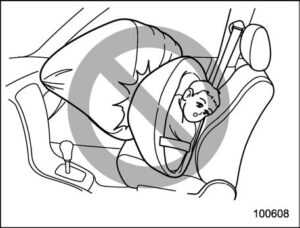
WARNING
- SINCE YOUR VEHICLE IS EQUIPPED WITH A PASSEN-GER’S SRS AIRBAG, NEVER IN-STALL A CHILD RESTRAINT SYSTEM IN THE FRONT PASSENGER’S SEAT. DOING SO RISKS SERIOUS INJURY OR DEATH TO THE CHILD BY PLACING THE CHILD’S HEAD TOO CLOSE TO THE SRS AIRBAG.
- Do not allow children to lean their heads or any other parts of their bodies against the door or the area of the seat, front and rear pillars or roof side rails. The SRS side airbags and SRS curtain airbags deploy even if children are seated in the child restraint system, and the impact could cause death or serious injury to the child.
- To secure the child restraint system, be sure to comply with all installation instructions provided by the child restraint system manufacturer. Not doing so could result in death or serious injury to children in a sudden stop or accident.
Choosing a child restraint system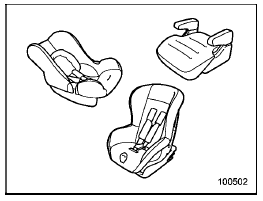
Choose a child restraint system that is appropriate for the child’s age and size (weight and height) in order to provide the child with proper protection. The child restraint system should meet all applicable requirements of Federal Motor Vehicle Safety Standards for the United States or of Canada Motor Vehicle Safety Standards for Canada. It can be identified by looking for the label on the child restraint system or the manufacturer’s statement of compliance in the document attached to the system. Also, it is important for you to make sure that the child restraint system is compatible with the vehicle in which it will be used.
NOTE
Some sizes of child restraint systems may not fit the vehicle seat. Before purchasing a child restraint system, check whether it fits on the vehicle seat.
Installing child restraint systems with ALR/ELR seatbelts
- When you install a child restraint system, follow the manufacturer’s instructions supplied with it. After installing the child restraint system, check to ensure that it is held securely in position. If it is not held tight and secure, the danger of your child suffering personal injury in the event of an accident may be increased.
- When installing a child restraint system in the rear center seating position, set both seatbacks to the original position. Otherwise, the child restraint system cannot be securely restrained, which may result in death or serious injuries in the event of a sudden stop, sudden steering maneuver or an accident.
Installing a rearward-facing child restraint system
- NEVER INSTALL A CHILD RESTRAINT SYSTEM IN THE FRONT PASSENGER’S SEAT. DOING SO RISKS SERIOUS INJURY OR DEATH TO THE CHILD BY PLACING THE CHILD’S HEAD TOO CLOSE TO THE SRS AIRBAG.
- Before installing a child restraint system, be sure to confirm that the seatback is securely locked into place. Otherwise, in an accident, serious injury or death could result.
- Place the child restraint system in the rear seating position.
WARNING
When you intend to install a child restraint system in the rear center seating position, if the child restraint system does not fit snugly against the contours of the rear center seat cushion, install the child restraint system in the window-side seating position to be safe.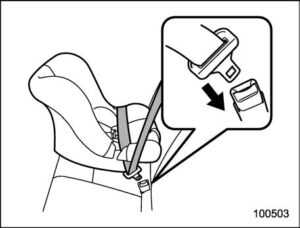
- Run the lap and shoulder belt through or around the child restraint system following the instructions provided by its manufacturer.
- Insert the tongue plate into the buckle until you hear a click.

- Take up the slack in the lap belt.
- If using the seatbelt in the ALR mode is recommended by the manufacturer’s instructions supplied with the child restraint system, perform the following procedure.
- Pull out the seatbelt fully from the retractor to change the retractor over from the Emergency Locking Retractor (ELR) to the Automatic Locking Retractor (ALR) mode.
- Allow the belt to rewind into the retractor. As the belt is rewinding, clicks will be heard which indicate the retractor functions as ALR.
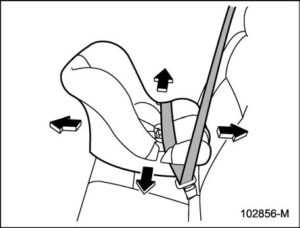
- Before having a child sit in the child restraint system, try to move it back and forth and right and left to check if it is firmly secured. Sometimes a child restraint system can be more firmly secured by pushing it down into the seat cushion and then tightening the seatbelt. It should not be possible to move the child restraint system more than 1 in (2.5 cm) in any direction along the seatbelt path.
- If the seatbelt has been set to the ALR mode in step 5, pull at the shoulder portion of the belt to confirm that it cannot be pulled out (ALR properly functioning).

- To remove the child restraint system, press the release button on the seat-belt buckle and allow the belt to retract completely. The belt will return to the ELR mode.
NOTE
When the child restraint system is no longer in use, remove it and restore the ELR function of the retractor. That function is restored by allowing the seatbelt to retract fully.
Installing a forward-facing child restraint system
- NEVER INSTALL A CHILD RESTRAINT SYSTEM IN THE FRONT PASSENGER’S SEAT. DOING SO RISKS SERIOUS INJURY OR DEATH TO THE CHILD BY PLACING THE CHILD’S HEAD TOO CLOSE TO THE SRS AIRBAG.
- Before installing a child restraint system, be sure to confirm that the seatback is securely locked into place. Otherwise, in an accident, serious injury or death could result.
- Place the child restraint system in the rear seating position.
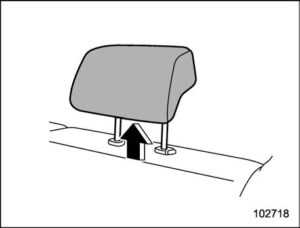
- If the child restraint system makes contact with the head restraint of the rear seating position where the child restraint system is to be installed, raise the head restraint to the extended position. If the child restraint system still makes contact, remove the head restraint.
CAUTION
Store the head restraint that has been removed in the trunk (Legacy) or cargo area (Outback/Subaru Outback Wilderness). Do not place the head restraint in the passenger compartment to prevent it from being thrown around in the passenger compartment at a sudden stop or a sharp turn. - For Outback/Subaru Outback Wilderness models, adjust the seatback to the upright position.
WARNING
When you intend to install a child restraint system on the rear center seating position, if the child restraint system does not fit snugly against the contours of the rear center seat cushion, install the child restraint system on the window-side seating position to be safe.
- Run the lap and shoulder belt through or around the child restraint system following the instructions provided by its manufacturer.
Run the lap and shoulder belt through or around the child restraint system following the instructions provided by its manufacturer.- When a child restraint system is installed on the rear center seating position, pass the rear center seat belt through the belt guide properly.
- Insert the tongue plate into the buckle until you hear a click.
- Take up the slack in the lap belt.
- Pull out the seatbelt fully from the retractor to change the retractor over from the Emergency Locking Retractor (ELR) to the Automatic Locking Re-tractor (ALR) function. Then, allow the belt to rewind into the retractor. As the belt is rewinding, clicks will be heard which indicate the retractor functions as ALR.
- Before having a child sit in the child restraint system, try to move it back and forth and right and left to check if it is firmly secured. Sometimes a child restraint system can be more firmly secured by pushing it down into the seat cushion and then tightening the seatbelt. It should not be possible to move the child restraint system more than 1 in (2.5 cm) in any direction along the seatbelt path.
- Pull at the shoulder portion of the belt to confirm that it cannot be pulled out (ALR properly functioning).
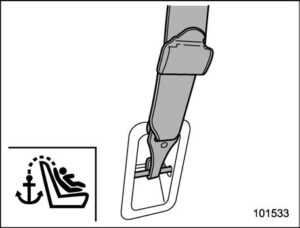
- . Latch the top tether hook onto the tether anchorage that is located behind the rear seat and tighten the top tether firmly.
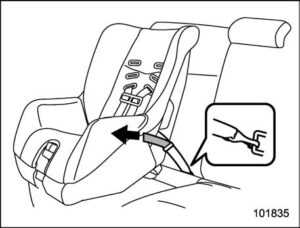
- To remove the child restraint system, press the release button on the seat-belt buckle and allow the belt to retract completely. The belt will return to the ELR mode.
Remember that the head restraint is not intended to be used at the lowest position (retracted position). Therefore, when the rear center seat is occupied (including when a child restraint system is installed) next time, be sure to raise the head restraint to the extended position.
NOTE
When the child restraint system is no longer in use, remove it and restore the ELR function of the retractor. That function is restored by allowing the seatbelt to retract fully.
Installing a booster seat or booster cushion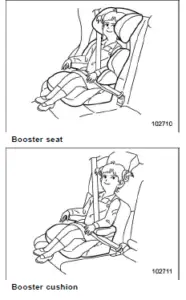
WARNING
Before installing a booster seat/cushion, be sure to confirm that the seatback is securely locked into place. Otherwise, in an accident, serious injury or death could result.
- Adjust the head restraint as follows.
For booster seat:

Raise the head restraint to the extended position. If the booster seat still makes contact, remove the head restraint.
- Remove the head restraint from the rear seating position where the child restraint system is to be installed.
- Store the removed headrestraint in the cargo area.
CAUTION
Do not place the head restraint in the passenger compartment to prevent it from being thrown around in the passenger compartment in a sudden stop or a sharp turn.
For booster cushion:
- Raise the head restraint to the extended position. If the booster seat still makes contact, remove the head restraint.
CAUTION
Store the head restraint that has been removed in the trunk (Legacy) or cargo area (Outback/Subaru Outback Wilderness). Do not place the head restraint in the passenger compartment to prevent it from being thrown around in the passenger compartment in a sudden stop or a sharp turn. - For booster cushion:
Raise the head restraint to the extended position. Do not remove the head restraint. 2. For Outback/Subaru Outback Wilderness models, adjust the seatback to the upright position.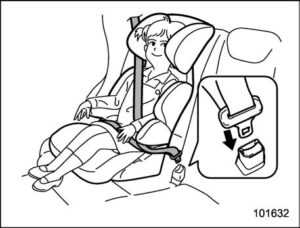
- Place the booster seat/cushion in the rear seating position and sit the child on it. The child should sit well back on the booster seat/cushion.
- If there is a gap between the booster seat/cushion and the seatback, adjust the seatback angle until good contact is achieved.
- Run the lap and shoulder belt through or around the booster seat/cushion and the child follows the instructions provided by its manufacturer. For a booster seat/cushion with a belt guide, use the seatbelt through the belt guide.
- Insert the tongue plate into the buckle until you hear a click. Take care not to twist the seatbelt. Make sure the shoulder belt is positioned across the center of the child’s shoulder and that the lap belt is positioned as low as possible on the child’s hips.
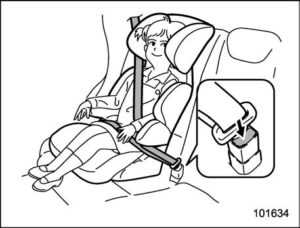
- To remove the booster seat/cushion, press the release button on the seat-belt buckle and allow the belt to retract. buckle and allow the belt to retract.
WARNING
- Never use a belt that is twisted or reversed. In an accident, this can increase the risk or severity of injury to the child.
- Never place the shoulder belt under the child’s arm or behind the child’s back. If an accident occurs, this can increase the risk or severity of injury to the child.
- The seatbelt should fit snugly in order to provide full restraint. Loose-fitting belts are not as effective in preventing or reducing injury.
- Place the lap belt as low as possible on the child’s hips. A high-positioned lap belt will increase the risk of sliding under the lap belt and of the lap belt sliding up over the abdomen, and both can result in serious injury or death.
- Make sure the shoulder belt is positioned across the center of the child’s shoulder. Placing the shoulder belt over the neck may result in neck injury during sudden braking or in a collision.
Installation of child restraint systems by use of lower and tether anchorages (LATCH)
Lower and tether anchorages
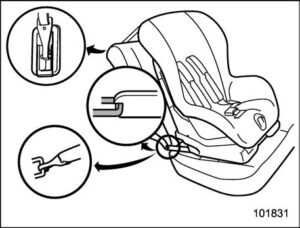
Outback/Subaru Outback Wilderness
- Attach the child restraint system to the anchors properly. When using the LATCH anchors, be sure that there are no foreign objects around the anchors. Make sure the child restraint system is securely attached. Otherwise, it may cause death or serious injury to children or other passengers in sudden braking, swerving, or accidents.
- When installing a child restraint system using LATCH anchors with the rear seatbelt fastened, ensure that the rear seatbelt does not become caught in the child restraint system or the lower LATCH anchorages.
NOTE
The seatbelt warning system of the rear seats detects if any of the seats are occupied by a passenger. Installing a child restraint system in the rear seating area, using the LATCH anchors, may result in the activation of the passenger seatbelt warning light and chime. Fastening the rear seatbelt prior to installing the child restraint system will avoid activating the passenger seatbelt warning light and chime. Some types of child restraint systems can be installed on the rear seat of your vehicle without use of the seatbelts. Such child restraint systems are secured to the dedicated anchorages provided on the vehicle body. The lower and tether anchorages are sometimes referred to as the LATCH system (Lower Anchors and Tethers for CHildren).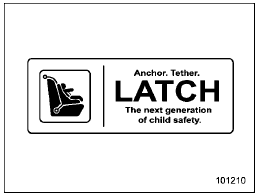
Your vehicle is equipped with five lower anchorages (bars) and three upper anchorages (tether anchorages) for accommodating such child restraint systems.
Lower anchorages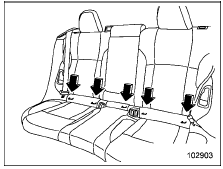
U.S.-spec. models
WARNING
Do not connect two or lower hooks onto the same anchorage (bar). There are a total of 5 lower anchorages at the rear seat. The second lower ancho-rage from the right side is used for both the right seat and the center seat. Each lower anchorage is located where the seat cushion meets the seatback.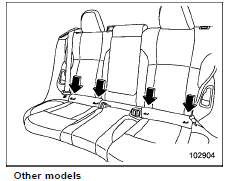
WARNING
Do not connect two or lower hooks onto the same anchorage (bar). Two lower anchorages (bars) are provided for installing a child restraint system on the rear seat window-side seating positions. Lower anchorages (bars) for window-side seating positions may be used for a seat in the center seating position if a child restraint system manufacturer’s instructions permit and specify using anchors as far apart as those in this vehicle. Each lower anchorage is located where the seat cushion meets the seatback.
Tether anchorages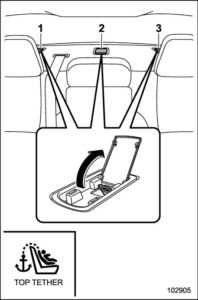
Legacy
- For right seat
- For center seat
- For left seat
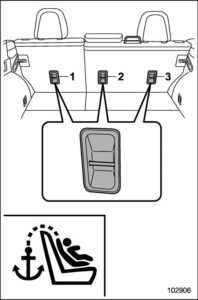
Outback/Subaru Outback Wilderness
- For left seat
- For center seat
- For right seat
The tether anchorages (upper anchorages) are provided at the locations shown in the above illustration.
To install a child restraint system using lower and tether anchorages
Before installing a child restraint system, be sure to confirm that the seatback is securely locked into place. Otherwise, in an accident, serious injury or death could result.
- Move the seat back back and forth to confirm that it is securely locked into place. Check the red colored unlocking marker which is attached to the bottom of the lock release knob is not visible.
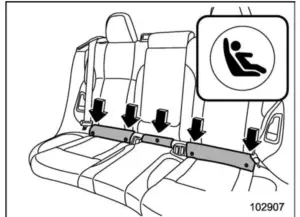
For U.S.-spec. models
other models - You will find marks at the bottoms of the rear seatback. These marks indicate the positions of the lower anchorages (bars).
Each lower anchorage is located behind the cover of the seatback bottom.
CAUTION
When you install a child restraint system, follow the manufacturer’s instructions supplied with it. After installing the child restraint system, check to ensure that it is held securely in position. If it is not held tight and secure, the danger of your child suffering personal injury in the event of an accident may be increased. off the anchorage cover completely from the selected side of the rear seatback to expose the anchorages (bars) to be used for the installation of the child restraint Peel off the anchorage cover from the selected side of the rear seatback. Fold the peeled anchorage cover in half and affix it with hook and loop tape to expose the anchorages (bars) to be used for the installation of the child restraint system.
Peel off the anchorage cover from the selected side of the rear seatback. Fold the peeled anchorage cover in half and affix it with hook and loop tape to expose the anchorages (bars) to be used for the installation of the child restraint system. - If it is hard to install the child restraint system because the anchorage cover returns to the original position, press the anchorage cover to the seat cushion until it is flat.
 CAUTION
CAUTION
Store the head restraint in the cargo area. Do not place the head restraint in the passenger compartment to prevent it from being thrown around in the passenger compartment in a sudden stop or a sharp turn.
- For Outback / Subaru Outback Wilderness models, adjust the seatback to the upright position. While following the instructions supplied by the child restraint system manufacturer, connect the lower hooks onto the lower anchorages located at marks on the bottom of the rear seatback. When the hooks are connected, make sure the adjacent seatbelts are not caught.
![Skip to main contentSkip to toolbar About WordPress Auto User Guide 764764 Comments in moderation New View Post SEOEnter a focus keyphrase to calculate the SEO score View Post (AMP) Howdy, Auto User Log Out Screen OptionsHelp Edit Post Add New Add title Subaru Legacy 2023 Child Restraint Systems Touring XT User Guide Permalink: https://autouserguide.com/subaru/legacy/subaru-legacy-20…ng-xt-user-guide/ Edit Edit with Elementor Add MediaAdd PDFVisualText ParagraphTOC Word count: 4584 Draft saved at 7:18:29 am. Last edited by Auto User on December 18, 2022 at 5:46 am Move upMove downToggle panel: Publish Preview(opens in a new tab) Status: Draft EditEdit status Visibility: Public EditEdit visibility Revisions: 2 BrowseBrowse revisions Publish immediately EditEdit date and time SEO: Not available Readability: Needs improvement Move to Trash Move upMove downToggle panel: Featured image Subaru Legacy 2023 feature Click the image to edit or update Remove featured image Move upMove downToggle panel: Tags Add New Tag Separate tags with commas Remove term: Child Restraint Systems Child Restraint SystemsRemove term: Legacy 2023 Legacy 2023Remove term: Owner Manual Owner ManualRemove term: Seats Restraints Seats RestraintsRemove term: Subaru SubaruRemove term: Subaru Legacy Subaru LegacyRemove term: Subaru Legacy2023 Subaru Legacy2023Remove term: User Guide User GuideRemove term: User Manual User Manual Choose from the most used tags Move upMove downToggle panel: Format Post Formats Standard Video Gallery Audio Quote Link Move upMove downToggle panel: Categories All Categories Most Used SubaruMake primary Legacy(Primary Category)Primary BMW 2 SERIES COUPE X5 PLUG-IN HYBRID Cadillac 3.0L CT4 CT5 Escalade Escalade ESV LYRIQ XT4 XT5 XT6 Chevrolet 3500/4500 4500 5500 HD/XD 6500/7500 Blazer Bolt EUV Bolt EV Camaro Colorado Corvette Equinox Express Express EUV Low Cab Malibu Silverado Silverado1500 Suburban Tahoe Trailblzaer Traverse Ford E-350 GMC Acadia Hummer EV Sierra Terrain Hyundai Accent Elantra Elantra Hybrid Elantra N Kona Kona Electric Kona-EV Kona-N Loniq 5 Loniq Electric Palisade Santa Cruz Santa Fe Santa Fe PHEV Sonata Sonata Hybrid Tucson Tucson Hybrid Veloster Kia Sportage Stinger Telluride Nissan ALTIMA ARMADA FRONTIER Toyota 4Runner 86 Avalon Avalon Hybrid BZ4X Camry Uncategorized Yukon Yukon XL Ascent BRZ Crosstrek Forester Impreza Outback Solterra + Add New Category Move upMove downToggle panel: Show AMP for Current Post? Show Hide Move upMove downToggle panel: Post Attributes Move upMove downToggle panel: Google News Exclude from Google News Sitemap Move upMove downToggle panel: XML Sitemap Priority Leave empty for automatic Priority as configured on Settings > XML Sitemap. Exclude from XML Sitemap Move upMove downToggle panel: Mobile Redirection for Current Page? Enable Disable Move upMove downToggle panel: Show Instant Article for Current Post? Enable Disable Move upMove downToggle panel: Yoast SEO Premium Move upMove downToggle panel: Yoast internal linking Move upMove downToggle panel: AMP Page Builder Start the AMP Page Builder Move upMove downToggle panel: Custom AMP Editor Use This Content as AMP Content If you want to add some special tags, then please use normal HTML into this area, it will automatically convert them into AMP compatible tags. Add MediaAdd PDFVisualText ParagraphTOC Copy The Content Move upMove downToggle panel: Revisions Auto User, 10 mins ago (December 18, 2022 @ 05:42:56) Auto User, 2 hours ago (December 18, 2022 @ 03:39:14) Move upMove downToggle panel: Table of Contents Disable the automatic insertion of the table of contents. Advanced: NOTE: Using the advanced options below will override the global advanced settings. Headings: Heading 1 (h1) Heading 2 (h2) Heading 3 (h3) Heading 4 (h4) Heading 5 (h5) Heading 6 (h6) Select the heading to consider when generating the table of contents. Deselecting a heading will exclude it. Alternate Headings Specify alternate table of contents header string. Add the header to be replaced and the alternate header on a single line separated with a pipe |. Put each additional original and alternate header on its own line. Examples: Level [1.1]|Alternate TOC Header Replaces Level [1.1] in the table of contents with Alternate TOC Header. Note: This is case sensitive. Exclude Headings Specify headings to be excluded from appearing in the table of contents. Separate multiple headings with a pipe |. Use an asterisk * as a wildcard to match other text. Examples: Fruit* Ignore headings starting with "Fruit". *Fruit Diet* Ignore headings with "Fruit Diet" somewhere in the heading. Apple Tree|Oranges|Yellow Bananas Ignore headings that are exactly "Apple Tree", "Oranges" or "Yellow Bananas". Note: This is not case sensitive. Thank you for creating with WordPress.Version 6.1.1 NotificationsNumber of media items found: 1 Close dialog Add media Actions Upload filesMedia Library Filter mediaFilter by type All media items Filter by date All dates Search Media list ATTACHMENT DETAILS Child-Restraint-Systems16.jpg December 18, 2022 24 KB 457 by 347 pixels Edit Image Delete permanently Alt Text Learn how to describe the purpose of the image(opens in a new tab). Leave empty if the image is purely decorative.Title Child Restraint Systems16 Caption Description File URL: https://autouserguide.com/wp-content/uploads/2022/12/Child-Restraint-Systems16.jpg Copy URL to clipboard ATTACHMENT DISPLAY SETTINGS Alignment Center Link To None Size Medium – 300 × 228 Selected media actions 1 item selected Clear Insert into post](https://autouserguide.com/wp-content/uploads/2022/12/Child-Restraint-Systems16-300x228.jpg)
- For models with rear seat reclining mechanisms, if there is a gap between the child restraint system and the seatback, adjust the seatback angle until good contact is achieved.
- If your child restraint system is a flexible attachment type (which uses tether belts), push the child restraint system into the seat cushion and pull both left and right lower tether belts up to secure the child restraint system by taking up the slack in the belt.
- Latch the top tether hook onto the tether anchorage that is located behind the rear seat and tighten the top tether firmly.
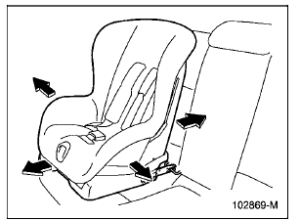
- Before having a child sit in the child restraint system, try to move it back and forth and right and left to check if it is firmly secured. Sometimes a child restraint system can be more firmly secured by pushing it down into the seat cushion. It should not be possible to move the child restraint system more than 1 in (2.5 cm).
- To remove the child restraint system, follow the reverse procedures of installation.
SUBARU recommends that you check with a certified Child Passenger Safety Technician to ensure the proper installation of your child restraint system. For more information, and to locate the closest inspection location in the U.S., refer to the National Highway Traffic Safety Administration (NHTSA) website. In Canada, check with Transport Canada.
Top tether anchorages
Your vehicle is equipped with three top tether anchorages so that a child restraint system having a top tether can be installed in the rear seat. When installing a child restraint system using top tether, proceed as follows, while observing the instructions by the child restraint system manufacturer. Since a top tether can provide additional stability by offering another connection between a child restraint system and the vehicle, we recommend that you use a top tether whenever one is required or available. Three tether anchorages are installed on the rear shelf behind the rear seat head restraint. Open the cover flap to use each anchorage.
Tether anchorage location
- For left seat
- For center seat
- For right seat
Three upper anchorages are installed on the back side of the rear seatback.
To hook the top tether
- Always raise the head restraint when mounting a child restraint system with a top tether. Failure to do so may prevent the top tether from being fastened tightly.
- If the head restraint is removed, store the head restraint in the trunk (Legacy) or the cargo area (Outback/Subaru Outback Wilderness).
- Do not place the head restraint in the passenger compartment to prevent it from being thrown around in the passenger compartment in a sudden stop or a sharp turn.
- Remove the head restraint when mounting a child restraint system. Otherwise, the top tether cannot be fastened tightly.
- Store the head restraint that has been removed in the cargo area. Do not place the head restraint in the passenger compartment to prevent it from being thrown around in the passenger compartment in a sudden stop or a sharp turn.
- Raise the head restraint at the seating position where the child restraint system is to be installed with the seatbelt or lower anchorages.
- Adjust the seatback to the upright position.
- Pass the top tether between the head restraint and seatback.

- Attach the top tether hook to the appropriate upper anchorage.
- Tighten the top tether securely.
SUBARU recommends that you check with a certified Child Passenger Safety Technician to ensure the proper installation of your child restraint system. For more information, and to locate the closest inspection location in the U.S., refer to the National Highway Traffic Safety Administration (NHTSA) website. In Canada, check with Transport Canada.
FAQ
It includes the LATCH system (Lower Anchors and Tethers for Children) for secure child seat attachment.
Typically, there are two sets of lower anchor points and three tether anchor points in the rear seats.
Yes, the LATCH anchors are designed for easy accessibility and use.
Yes, the rear seats are spacious enough to accommodate rear-facing infant seats.
Yes, the Legacy Touring XT can comfortably fit front-facing child seats.
The vehicle’s safety systems, including the LATCH system, ensure the child seat remains securely in place during a collision.
Yes, booster seats can be safely used, especially with the rear seat belt systems designed to accommodate them.
The Legacy Touring XT typically does not come with integrated child seats but is compatible with most standard child seats.
Yes, the LATCH system makes it relatively straightforward to install child seats securely.
It may have a passenger airbag deactivation feature, which is important when using a rear-facing child seat in the front passenger seat.
It can typically accommodate two child seats in the rear, though this can vary based on the size of the seats.
Beyond the LATCH system, the vehicle incorporates various safety features that indirectly benefit child passengers, such as advanced airbag systems and structural safety designs.
While possible, it is generally recommended to install child seats in the rear for maximum safety.
Yes, the Legacy Touring XT includes child-proof door locks and power window controls that can be disabled for child safety.
The vehicle offers ample storage space, including in the trunk and various compartments, suitable for storing child-related items.
Useful Link
View Full User Guide: Subaru Legacy 2023 Touring XT User Guide
Download Manuals: https://www.subaru.com/owners/vehicle-resources/manuals.html
2024 Subaru Legacy Specs, Price, Features, Mileage (Brochure)

